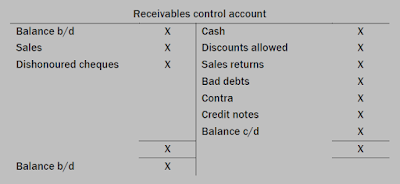Method 1: the ‘two account’ approach
for accrued expenses
This is the easier approach. Also note that
it is the method used in computerized accounting systems.
The accrued expense is recorded in an accrued
expenses account. The double entry for this adjustment is as follows
Illustration:
Accruals using two accounts.
Debit Credit
Expense account X
Accruals account X
This adds the accrued expense to the expenses recognised
as the result of having received invoices earlier in the current accounting
period.
The credit balance on the accruals account is a liability,
and is included in the statement of financial position as a current liability.
Example: Year 1
Payments
in the year were:
Rs.
30
April 5,000
31
July 7,500
31
October 8,500
The accrual for November and
December Year 1 is Rs. 6,000 (Rs. 9,000 × 2/3).
Method 1: two
account approach
 |
Method 1: two
account approach
|
The
expense in the statement of comprehensive income for Year 1 is Rs. 27,000 and
the accrued expense of Rs. 6,000 is included in the statement of financial position
as a current liability at the end of Year 1.
Reversal of the accrual
There is a complication. At the year end the
expense account is cleared to the statement of comprehensive income and there is
a credit balance carried down on the accruals account.
Assume that the invoice that arrives in
January is Rs. 9,500. The accounting system will record the following double
entry:
Example: January
invoice received
 |
|
invoice received |
However, an expense of Rs. 6,000 and a liability of Rs.
6,000 has already been recognised in respect of this invoice. If no further
adjustment is made the 6,000 is being included twice.
In
Year 2, the telephone invoices are as follows:
Rs.
31
January 9,500
30
April 9,500
31
July 10,000
31
October 10,000
To
calculate the telephone expenses for Year 2, it is necessary to estimate the expense
for November and December, and to make an accrual.
The
next invoice (at the end of January Year 3) is expected to be Rs. 10,500.
The
accrual for November and December Year 1 should be Rs. 7,000 (Rs. 10,500 × 2/3).
Method 2: the ‘one account’ approach
for accrued expenses
This approach is trickier to understand. The
accrual is recognised in the expense account.
There are two ways of achieving this.
- The total expense can be
calculated and transferred to the statement of comprehensive income (Dr
Statement of comprehensive income; Cr
Expense account) leaving a balancing figure
on the expense account as an accrual; or
- The accrual can be
calculated and recognised in the expense account leaving the amount transferred
to the statement of comprehensive income
(Dr Statement of comprehensive income; Cr
Expense account) as a balancing figure
Example: Year 1
Wasif set up in business on 1 January Year 1. The business has a
31 December year end.
The business acquired a telephone system on 1 February.
Telephone charges are paid every 3 three months in arrears and
telephone invoices received in Year 1 are as follows:
Rs.
30 April 5,000
31 July 7,500
31 October 8,500
To calculate the telephone expenses for Year 1, it is necessary to
estimate the expense for November and December, and to make an accrual.
The next invoice (at the end of January Year 2) is expected to be
Rs. 9,000.
The accrual for November and December Year 1 should be Rs. 6,000
(Rs. 9,000 × 2/3).
Method 2: one account approach
 |
| one account approach |
In
order to make the above work either:
- Calculate the expense transferred to the statement of comprehensive income
(27,000) and calculate the accrual taken as a balancing figure; or
- Calculate the accrual needed (6,000) and then calculate the expense transferred
to the statement of comprehensive income (27,000) as a balancing figure
(6,000). This is usually the easiest way.
There is no need to reverse the accrual using the one
account method as it is nalready in the expense account at the start of the
next year.
Calculating the expense for the statement of comprehensive
income
Method 2 requires the calculation of either
the closing accrual or the charge to the statement of comprehensive income, the
other number being taken as a balancing figure. It is almost always easier
to calculate the accrual.
The amount charged to the statement of
comprehensive income can be calculated as follows. It is worth spending a
little time trying to understand this.
Illustration:
Rs.
Invoices/payments for the year X
+ Closing accrued expense X
X
– Opening accrued expense (X)
= Expense for the year X







